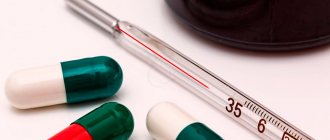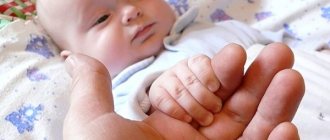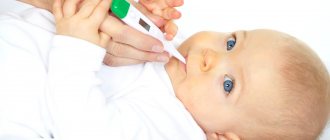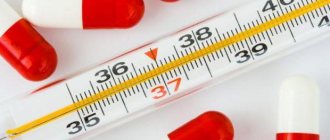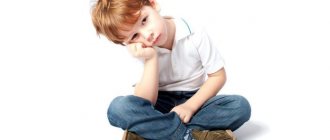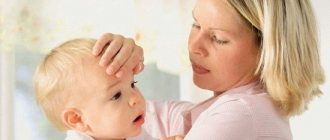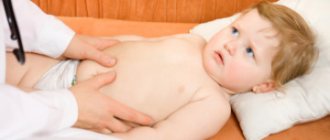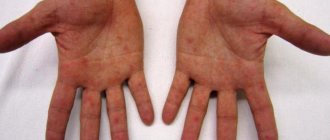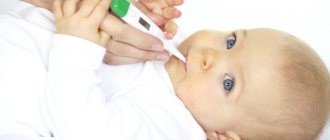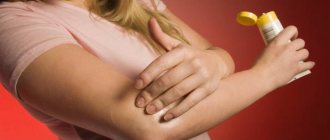Why do my child's cheeks turn red? allergy.
Emissions of harmful substances into the air at work, exhaust gases, animal hair, plant pollen, house dust - the list of allergens that surround a child every day can be listed endlessly.
If an allergic reaction develops, in addition to redness of the cheeks, the child will have symptoms such as lacrimation, sneezing, nasal congestion, cough, general malaise, etc. Unlike colds, which are also characterized by the above symptoms, when an allergy occurs, the body temperature does not rise.
Allergies can develop suddenly or be the result of constant contact with allergens. An illustrative example of development is the appearance of a blush on the cheeks and other allergy symptoms in a child after prolonged use of medications.
Contact dermatitis is why a child's cheeks turn red. This is a reaction of the skin in response to an allergen, which is most often skin care products (soap, bubble bath, shampoo, moisturizer). In this case, redness will appear not only on the cheeks, but also on other areas of the skin in contact with the cosmetic.
What to do?
It is not possible to completely cure allergies, but stable remission of the disease can be achieved. Parents have the power to limit contact with the allergen. If there is a suspicion that allergies are caused by plant pollen or house dust, daily wet cleaning of the house and installing an air purifier in the children's room will be sufficient to alleviate the condition.
IMPORTANT! The selection of antihistamine (antiallergic) drugs is carried out by a pediatrician! Uncontrolled treatment can lead to the development of serious complications.
A light blush on the cheeks has always been considered a sign of excellent health, and parents, without exception, rejoice at this manifestation - it means that the child’s circulatory system is working well. But it is worth distinguishing between an ordinary healthy blush and a painful redness of the cheeks. Surprisingly, red cheeks are a very common symptom and can indicate a variety of health problems, ranging from frostbite to infectious diseases and dangerous allergic reactions.
The main reason to be wary is the sudden appearance of redness. So, if your cheeks become flushed after active games, running and other physical activities, then this is quite natural and normal. Sometimes the baby’s face turns red due to an increase in body temperature - here you need to understand the reasons for this reaction of the body.
But when the child’s skin turns red sharply, and without any noticeable reasons, then you should consult a doctor. The examination will help to identify the specific cause causing this symptom and will allow you to combat it in a targeted manner. Let's find out what can cause reddening of a child's cheeks.
Causes
The causes of rashes in a child can be very diverse: as well as diseases of the blood and blood vessels.
Allergic reactions
(allergic dermatitis). The most harmless type of rash. The reason is the body's reaction to the allergen:
- Food;
- medicines;
- dust;
- plant pollen;
- animal hair, etc.
The rash appears quite quickly - within an hour after contact with the allergen. The main difference between urticaria and rashes of infectious origin is the normal general condition of the child: no fever, no nausea. Just rash and itching. In case of severe allergic reactions, a dangerous condition may additionally occur - Quincke's edema (characteristic swelling of the soft tissues of the face - lips, cheeks, eyelids, which can involve the neck, tongue and respiratory tract).
Hives can be easily relieved by taking antihistamines. However, it cannot be ignored.
dangerous
Any allergy can one day result in anaphylactic shock. Therefore, a child with allergies should be seen by a doctor.
Infectious diseases
In infectious diseases, in addition to the characteristic rashes, there are general symptoms of intoxication (fever, malaise, headache, possible nausea and vomiting). All infectious diseases require isolation of the patient.
Let's look at the most common childhood infectious diseases.
| Disease | Features of the rash, other symptoms | Notes |
| Vesicular (bubbles with liquid) rash. Appears in “jumps” and covers the scalp (this is one of the few diseases in which there are rashes under the hair) and the entire body. | The disease is easily transmitted. Only the symptoms are treated - fever, malaise, the rash is smeared with a solution of brilliant green. | |
| The rash appears sequentially: first on the head, then on the torso, then on the limbs. After the rash disappears, pigmentation remains (about 2 weeks), then goes away. Additional symptoms: conjunctivitis, photophobia, Belsky-Filatov-Koplik spots (white small spots on the mucous membrane of the inner part of the cheeks - in the oral cavity). | Treatment is symptomatic. | |
| Rash all over the body, especially on the extensor surfaces of the limbs, back, buttocks. Does not merge. The posterior cervical and occipital lymph nodes are enlarged (even before the rash appears). | Treatment is symptomatic. ATTENTION! If rubella is suspected, it is necessary to completely exclude the child’s contact with pregnant women, because The disease suffered during pregnancy threatens the development of fetal defects. | |
| Meningococcemia (one of the generalized forms of meningitis) | Stellate hemorrhagic (bloody, bright) rash on the buttocks and legs. May be accompanied by general symptoms of damage to the meninges: the back and neck are tense, the child is arched. Vomit may be the color of coffee grounds. | Urgent isolation and hospitalization is required. Treatment is carried out with antibiotics as prescribed by a doctor. |
| The localization of the rash is very characteristic: a bright, confluent rash over the entire face and body, but it does not cover the nasolabial triangle. After the rash passes, peeling occurs. Additional symptoms: the cervical lymph nodes are enlarged, the tongue is initially coated, then acquires a bright crimson color. | Treatment is carried out with antibiotics as prescribed by a doctor. |
Parents of small children always have a lot to worry about. But when a child is sick, they all fade into the background, since there is nothing more valuable than the baby’s health. What is especially difficult is that few parents are able to react correctly and recognize the true diagnosis. This is what medical professionals are there for. And yet it will not be superfluous to know what this or that sign indicates.
Today we will talk about a case where a child suddenly developed red spots on his body. They may differ in appearance and be symptoms of completely different diseases. Let's look at such situations in more detail.
Allergic reaction
This is the most common reason today why red spots appear on the face, head and body of a child. An allergy as a negative reaction of the body can occur to anything - to formula milk, a new food that a child or his mother has tried, to baby cosmetics, diapers of a certain brand, etc. A child's allergy looks like large red or pink spots that most often dry and rough. Sometimes the reaction manifests itself in the form of small pimples on the face or inflammation of the skin under the diaper.
If the child’s diagnosis of “allergic diathesis” is confirmed, the doctor will prescribe treatment, including antihistamines and a diet. After starting treatment, the red spots will disappear, but not immediately, but within a few weeks.
Mosquito bites
Mosquitoes and other insects attack children even more often than adults. At the same time, an ordinary mosquito bite can cause a skin reaction very similar to an allergic one. If after an evening walk the child is covered with red spots that itch and itch, it looks like he was bitten by mosquitoes. Help with bites consists of lubricating the spots with an antiallergic drug in the form of a gel or brilliant green if the baby scratches these red bumps on the skin.
Prickly heat
In the summer heat, children are often overcome by the so-called sweat rash - a small rash in the places where clothing adheres to the body. Such problems arise especially often in babies who wear diapers. A characteristic sign of bites is that the rash does not itch and does not bother the child in any way.
It’s easier to fight prickly heat than allergies—you only need to eliminate the external manifestations. Baths with herbal infusions (calendula, walnut leaves) and the use of powder help. It also makes sense to dress your child in clothes made from natural fabrics.
Childhood infections
Very often, the appearance of spots in a child means he is infected with one of the childhood infections. Pay attention to the nature of the spots and the presence of other symptoms.
These are not all the reasons: for example, the appearance of convex, flaky red spots on a child’s skin may indicate development.
Therefore, never self-medicate if your child suddenly develops a rash all over his body, especially if it is accompanied by alarming symptoms such as diarrhea, vomiting and fever. This is simply dangerous, and if such situations occur, you should consult a doctor.
There are many factors that cause red spots to appear on a child's body. This may be due to a dangerous infectious or viral disease, allergies, or a common insect bite. Almost always, the rash is accompanied by hyperthermia, which indicates a protective reaction of the baby. Red spots on a child’s body and elevated temperature are a significant reason for a visit to the pediatrician, because some diseases can be very difficult for a weak child’s body to tolerate.
Why does the child have red cheeks?
Quite often, mothers observe such a phenomenon as redness of the baby’s cheeks. However, not everyone tries to understand this situation, attributing it to individual characteristics or simple overheating.
Why do babies' cheeks turn red?
There are quite a few reasons why a child’s cheeks become red. The most common of them:
- sudden change in ambient temperature;
- diathesis;
- problems of the cardiovascular system;
- infectious process.
So, the most harmless of the reasons listed above is the so-called chapping. Often mothers, especially in the cold season, note that after a walk the baby’s cheeks become red. In order to prevent this phenomenon, it is enough to lubricate the child’s cheeks with baby protective cream before going outside. Also, recently cases of allergies to cold have become more frequent, as a result of which the cheeks become very red.
The phenomenon of diathesis deserves special attention, which in most cases explains why a child’s cheeks become red. In such cases, this reaction is observed after introducing a new product into the child’s diet.
In cases where a child has hot, red, or even burgundy cheeks, and they turn red in the evening, you need to think about the development of a cold. In this case, it is enough to measure your body temperature to clarify the situation. In addition, this kind of redness can also be caused by an allergic reaction.
A symptom such as crimson cheeks in a child may indicate the presence of a cardiovascular disorder in the baby’s body. This phenomenon is observed, in particular, with such a pathology as an abnormal development of the heart - a functioning oval window, in which arterial blood mixes with venous blood.
What to do if your baby's cheeks turn red?
When the baby's cheeks are red, the first thing the mother should do is rule out a cold, by simply measuring the body temperature. If it is elevated and is 38.5 degrees, it is necessary to give an antipyretic.
In cases where redness is caused by diathesis, it is enough to exclude the allergenic product from the baby’s diet.
If there are suspicions of diseases of the cardiac system, you should contact a pediatrician who will prescribe an ultrasound of the heart.
The blush on a baby's cheeks is traditionally considered an indicator of good health. However, in some cases it may be a sign of some pathology in the body. Therefore, it is very important to correctly assess the causes of its occurrence and promptly contact a pediatrician. For example, if a baby’s cheeks and chin turn red in the evening, but the rest of the time there is no blush, it is advisable to undergo an examination.
What to do if a rash appears on the face and neck of a newborn
This type of rash is physiological. The reason for the appearance of rashes is hormonal changes in the baby’s body, adaptation to living conditions outside the mother’s womb and cleansing the baby’s blood of excess female hormones. In appearance, newborn acne is a small red rash localized on the face, head, neck, and back.
In order to get rid of neonatal rash (pustulosis), you must first distinguish it from other rashes (this will be done by your pediatrician). With the right approach in terms of the baby’s personal hygiene, maintaining the necessary microclimate in the baby’s room and calmness on the part of the mother, the rash will go away on its own without drug intervention. Symptoms usually disappear after three weeks.
The first step is to contact your pediatrician. You may need to consult an allergist. Self-medication should be excluded!
1. A small itchy rash all over the body is a sign of heat rash. In this case, it is necessary to observe the temperature regime and a certain humidity in the child’s room, correct latching to the breast, daily bathing (preferably twice a day) with decoctions of chamomile and/or string.
2. A rash on the cheeks is a sign of diathesis. In this case, the nursing mother needs to reconsider her diet or, if artificial feeding, change the milk formula. The doctor may prescribe mild antihistamines, which are allowed at this age, or instead of them, a chamomile decoction (a teaspoon for mother or baby).
3. A rash on the neck is one of the symptoms of contact dermatitis. Treatment is elimination of the allergen. How to apply such a rash on a newborn? You can use (only after consulting a doctor) Bepanten ointment for rashes or Sudocrem.
4. A rash on the abdomen may be a sign of atopic dermatitis. In this case, the doctor prescribes antiallergic drugs and probiotics (for example, Bifidumbacterin according to the scheme). It also requires a diet for the mother and proper daily hygienic care for the newborn.
5. Rash in the groin and perineum. One of the symptoms of diaper dermatitis. What is important here is strict adherence to personal hygiene, the use of baby care items and clothing only from hypoallergenic materials, and the use of Bepanten cream. If the cause of the rash is an infectious disease, then parents need to responsibly follow the doctor’s recommendations in order to avoid bad consequences.
The most common is an allergic rash in infants. It can appear for many reasons and have different localizations. Often, an allergic rash in a baby appears due to the fault of a loving mother who is trying to diversify her diet with various products to improve the nutritional value of her milk.
As a result: the baby’s cheeks, shoulders, arms and tummy “bloom” with a riot of red spots. Soon they will develop into flaky scales or take on the appearance of scabs. It is the mother who must react in a timely manner to such manifestations on the baby’s skin. After all, the child is breastfed.
For bottle-fed babies, a rash can be caused by improperly selected formulas. Each mixture has its own special structure, which may or may not be ideal for the needs of a particular baby. In this case, in addition to skin rashes after eating, the child may experience excessive belching. The baby's rash will go away if you choose another highly adapted mixture.
Often an allergic rash appears in infants as a result of early introduction of complementary foods. The baby's digestive tract is not yet filled with all the necessary enzymes. As a result, he is simply unable to properly digest all food. It is necessary to temporarily stop feeding with this particular product and change it to another.
Neonatal acne occurs in ¼ of babies in the first weeks of life. Mostly, a hormonal rash in a child appears on the cheeks, scalp and neck. These skin rashes are absolutely safe and not contagious. It is not recommended to get rid of them using special ointments, tinctures and other folk methods.
There are several reasons why a red rash occurs in a baby. The most common problem causing red spots is hyperhidrosis. A similar skin rash appears due to overheating. As a result, skin pores become clogged. A large amount of liquid collects in them.
Small red bubbles appear. Basically, such a red rash in infants occurs in the armpits, under the knees and in places where a large amount of clothing fits tightly. Basic hygiene, air baths and bathing in a decoction of the string will help to quickly cope with such skin rashes.
A red rash in a baby can also appear due to toxic erythema. Such skin rashes can appear on a child’s skin in the first weeks of life, mainly on the face. After a couple of weeks, such skin changes go away on their own.
Due to improper care of the groin area, children often develop diaper rash in the form of a red rash. They can be dealt with exclusively by timely and proper hygiene and drying ointments.
In rare cases, mainly in formula-fed children, a rash of an infectious nature appears. Along with it, fever and some other symptoms may be observed. An urgent examination by a pediatrician and possible hospitalization are required.
Almost always, a small rash in a baby appears against the background of allergies, both contact and food. If the allergen stops entering the bloodstream, the body’s allergic reactions stop and the rash goes away on its own. It is important to remember that cosmetic elimination of the rash using creams can only remove external manifestations. Internal inflammation will still remain.
READ ALSO: Boils on the body - causes of boils
If a small rash in a baby begins to grow and take on a more pronounced form, then the cause may be an infectious disease.
Often, a rash on the face of a baby, localized in the cheek area, occurs as a result of diathesis. Babies, both breastfed and bottle-fed, received their share of the allergen from formula or mother's milk. The result is “rosy” cheeks that do not bring any joy. After one or two days, peeling may begin. It is necessary to follow a diet.
It is very difficult to say unequivocally why a rash appeared on a baby’s face, since there can be many reasons for this:
- hormonal predisposition;
- change in temperature;
- contact allergy;
- genetic disorders;
- infectious diseases;
- improper functioning of the gastrointestinal tract.
First, you need to visit a pediatrician who can correctly determine the nature of the rash based on external signs and refer you to the right specialist.
Rash on baby's head
Almost always, a rash on the head of a baby is caused by seborrheic dermatitis. As the skin dries, it separates into small yellow scales. To get rid of this type of rash, proper hygiene and combing are necessary.
If a baby's body rash is light in color and does not merge into one spot, then the cause of its appearance is most likely a contact allergy. Perhaps the child had an allergic reaction to the washing powder that was used to clean his laundry.
In the case of a drug allergy in an infant, a rash on the body, after taking certain medications, initially looks like small light dots, the number of which increases every hour, and the color changes to a red tint. In some places the rash begins to merge. In this case, hospitalization is necessary, since the body has become intoxicated with allergens that need to be removed. Droppers and taking antihistamines are advisable.
Especially in the summer, a rash on the neck of a baby can be caused by prickly heat. These reddish dots form around the entire perimeter of the neck, especially in areas under the hair. The rash has a reddish tint and looks like small blisters. Rational hygiene, avoidance of synthetic items, and constant cleansing of the surface of the neck are advisable.
Allergic reactions and infectious diseases can also cause a rash on the neck. In the first case, the reason may lie either in contact with direct allergens or in their consumption with mother's milk.
If the rash on the neck of the baby begins to change and take on the shape of vesicles, becoming more intense, then you cannot do without contacting a pediatrician. Most likely, it is infectious in nature.
Even a minor rash on a baby’s stomach can indicate serious illness. Although it is often caused by allergic reactions or poor hygiene. The prerequisites for the appearance of a rash on the stomach of a baby may be:
- lichen;
- dermatitis;
- eczema;
- allergy;
- measles;
- rubella;
- staphylococcus;
- scarlet fever;
- scabies;
- erythema infectiosum;
- sweat rash;
- blood diseases;
- vascular diseases and others.
If a rash appears on a child’s stomach, it requires prompt diagnosis. Having noticed the rash in a timely manner and comparing the main symptoms, it is necessary to undergo a course of treatment that can quickly and painlessly return the baby to its former health.
Facial rashes in newborns can occur for many reasons. Let's look at the most common ones.
- Milia. A small white or yellowish rash on the nose, cheeks and chin occurs in half of newborns and goes away on its own within the first month of life.
- Acne of newborns. A colorless or red rash on the cheeks of a baby (sometimes around the eyes, forehead and nose) indicates the formation of a hormonal background and goes away on its own within a few weeks. Only in rare cases do such acne indicate a hormonal imbalance.
- Irritation. When the time comes for teething, the baby begins to salivate profusely. Because of this, the child often develops a pinpoint rash on the chin.
- Toxic erythema. A rash in the form of red spots with small white or yellow blisters appears in infants around the joints, on the chest and abdomen. This phenomenon usually occurs on days 2-4 of life. The child may be bothered by the itching, but this will go away within a few days. This phenomenon is not dangerous to health and indicates the child’s adaptation to the external environment.
- Seborrheic dermatitis. A yellowish rash in newborns in the form of greasy or hard scales on the face and head is quite common and goes away on its own within a year.
Wrong care
- Prickly heat. A red rash on a baby's neck, which can turn into small white pimples, may indicate that the baby is overheated. This happens in hot climates or simply among parents who are always afraid that their child will freeze. If, at the first signs of heat rash, the child continues to be wrapped, then the rash in newborns can spread to all natural folds of the skin and the head. As soon as the child gets into normal climatic conditions, prickly heat quickly disappears.
- Diaper rash. Red small pimples on the butt, in the groin folds and in the genital area (sometimes also in the armpits and on the neck) may indicate improper hygiene (rare bathing, untimely changing of the diaper) or a fungal infection.
- Diaper dermatitis. As a rule, it is a consequence of improper care of the baby and manifests itself as red merging spots on the folds of the neck, buttocks, and genital area. Then small papules (bubbles) appear, the skin begins to peel off, wounds and erosions appear. If measures are not taken in a timely manner, staphylococcal and fungal infections may occur.
READ ALSO: Treatment of boils: 7 best methods in the fight against boils
Allergy
- Allergic dermatitis, urticaria. A red, scaly rash on the baby's face, which gradually spreads to the ears, neck, back, chest and stomach, is most often a sign of an allergy. The reason may be the diet of a nursing mother (the presence of allergens in the diet such as seafood, peanuts, strawberries, etc.), inhalation of dust or dander from pets, a reaction to washing powder, to foods in complementary foods, to medications. Sometimes a colorless rash can indicate an allergy. For example, with lactase deficiency (allergy to whole milk).
- Atopic dermatitis (eczema). A red itchy rash on a baby's body appears before the age of 6 months and is usually associated with an allergy to milk and egg whites (eaten by the nursing mother or the baby itself). First, elements of the rash appear on the face, scalp and torso, and as the child gets older, they can appear in the natural folds of the skin, in the popliteal cavities and elbow bends.
Infections
- Impetigo. A skin disease that manifests itself as painful red spots around the mouth, nose, arms and legs. This is a highly contagious disease that most often affects infants, but it is easily treated with antibiotics.
- Scabies. This problem can occur at any age, and it cannot be avoided without the help of a doctor. A small itchy rash in infants spreads throughout the body, including the soles of the feet. The disease can be treated with special creams or sprays, but all family members should be treated.
- Measles. If a red rash on the face of a month-old baby is combined with a high fever (about 38 degrees), swelling under the eyes, cough and runny nose, these may be signs of measles. See your doctor as soon as possible.
- Varicella (chickenpox). The disease begins with one small red spot, on which a blister appears within a few hours. There can be from a few to hundreds of such elements. The child may have elevated body temperature, nausea, muscle pain, and loss of appetite. Consult your doctor for clarification of the diagnosis.
When is cheek redness not normal?
There is a certain list of internal reasons that cause redness of the cheeks. And for the most part, they indicate that the body is not well. If a one-time redness occurs in a situation where a person is embarrassed or scared, this is the norm; here the redness is formed by the release of adrenaline. However, if the face turns red frequently and for no reason, or if the redness lasts for a long time, we may be talking about illness. In such a situation, an examination is necessary.
Redness can be caused by problems with blood supply and various types of disorders. We can also talk about vegetative-vascular dystonia. In addition, redness occurs due to hormonal imbalances, metabolic disorders, diabetes, allergies, and menopause. And redness can also manifest itself during pregnancy, in the first stages of pulmonary tuberculosis, endocrine problems and high blood pressure.
Red cheeks as a result of infection
Redness of the cheeks in children 6 months old is a consequence of the virus. As a rule, this occurs against the background of colds. Redness in this case is accompanied by weakness, profuse nasal discharge, fever, lack of appetite and other typical symptoms. ARVI is not the only cause of red cheeks. Pathology can be observed in several other cases:
- baby roseola. As a result of this disease, the child experiences a sharp increase in body temperature, a red rash and diarrhea with mucus;
- infectious erythrema. This disease is caused by parvovirus B12 and is accompanied by general malaise, diarrhea, weakness and nausea. If the skin around the mouth turns pale and the redness is accompanied by a rash, take your child to the doctor immediately;
- lupus erythematosus. This disease can be recognized by the redness of the cheeks and the peculiar shape of the rash - red rashes have the shape of a butterfly. The rash usually spreads throughout the body and is accompanied by disruption of the heart, joints, kidneys and spleen. Additional symptoms include general malaise and fever.
